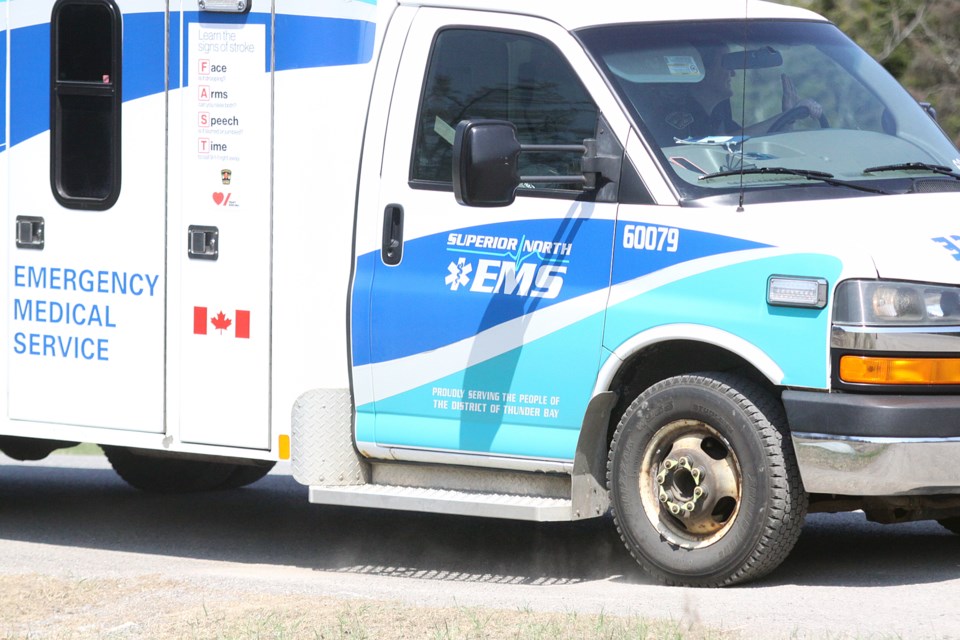GREENSTONE — An adaptive and novel approach to medical service is addressing care gaps in Beardmore.
Since May 2023, residents of Beardmore, Animbiigoo Zaagi'igan Anishinaabek (AZA) First Nation, Bingwi Neyaashi Anishinaabek (BNA) FN, Biinjitiwaabik Zaaging Anishinaabek (BZA) FN, and Jellicoe have had access to the Community Paramedic / First Response program.
Currently, there is one paramedic working 12 hours — four days on, four days off.
Greenstone Mayor James McPherson says that he is “grateful” that these communities have the paramedic in place, particularly following the loss of Beardmore’s EMS station.
“Part of the restructuring of Superior North EMS was the loss of that service in the Beardmore ward,” McPherson said, “and we did our bit to encourage funders that the base is needed — not just for the Beardmore ward of Greenstone but the [First Nations] communities of AZA, BZN, and BNA.”
“In addition to Beardmore ward, those three communities also lost that service. And so, now it’s been replaced with the community worker.”
One of the many benefits of the paramedicine program is that the worker has a chance to grow familiar with residents in the community.
McPherson says it all ties into “community outreach.”
Jim Greenaway, commander of community safety and planning at Superior North EMS, spoke in detail about how the program works and how it is having a positive impact on the community.
“Our Beardmore community paramedicine program is an initiative to, essentially, accomplish two goals: the first is to act as a health system enhancer by working with healthcare providers in not just Beardmore, Jellicoe communities but also with our First Nations partners, BNA, BZA, and AZA. We’re really looking to provide care for those communities in the right place, at the right time, in-person.”
“The second major goal is to provide a resource that can respond to emergencies in a first response capacity. Our community paramedic can respond to a 9-1-1 call [and] have a unit that has all the life-saving devices that an ambulance would have, except it’s non-transporting. If an emergency comes through the paramedic, if they’re on-duty, will respond to the call, provide life-saving treatment while another unit from a further community can come in to transport them. Every time our paramedic has been on-duty, he has responded to those calls in a very timely manner and been able to provide treatment… I’d say up to this point, it’s been successful.”
Greenaway highlighted the fact that the program really is a partnership and offers healthcare providers a more “flexible” model than a traditional setup.
“If a unit comes, that community paramedic can jump-on with the responding crew and provide extra hands and support for that patient during the call as well,” Greenaway said.
He said that the partnership between Superior North EMS and the Beardmore Clinic has been “fruitful” when it comes to this community paramedicine initiative.
“It’s really been a great partnership because any health concerns we believe should first be addressed by primary care, if possible, to overcome barriers in the community, divert people from the emergency room, and really try to preserve their capacity for very acute issues that require that level of treatment in the ED.”
Greenaway mentioned some of the new services that the program is bringing to Beardmore (and the other communities the paramedic serves) including “safe needle drop-off” and “remote patient monitoring.”
The scope of the program is growing, but, with that growth, comes staffing concerns.
“It’s been a little bit of a slow uptake,” Coun. Claudette Trottier said at a Greenstone municipal council meeting on Oct. 10.
“That’s to be expected with any new programs, by getting referrals from our community, from the Indigenous communities in the area as well … We still only have the one person in place.”
The mayor mentioned the challenge to retain people in northern communities.
“People that come up to the north, in our community, they’re usually young out-of-school people,” McPherson said. “They’ve got family somewhere else and unless they create a family in our area they will head back to wherever their family and friends are.”
Greenaway echoed Trottier’s remarks, however, saying that it takes time for programs like this to “reach their fullest potential,” particularly in finding its “niche” and with the relatively short amount of time the program has been active.
He is hopeful, despite it being “early days,” that they can hire a second paramedic for the program and extend the program’s reach.
“We are considering, strategically, to expand into those areas so that we can maintain what we’ve provided in Beardmore but also expand to other areas where they might be able to use the services as well,” Greenaway said.
With an ongoing physician shortage in the north, the Beardmore community paramedic initiative is just one example of how northern communities can adapt to address gaps in care and alleviate some of the strain on EMS workers across the region.
“I just want to stress that we’re very happy with how the program’s going,” Greenaway said. “We’re very happy with our partners, the Beardmore Clinic, the First Nations, and our community paramedics that are out there doing really good work.”
“We’re just trying to find out ways to be strategic, to help more people, and better use our resources… we want to provide a very high level of service — all of our paramedics, both community and operational, they’re very dedicated [to] providing great patient care, and we just try to do this so we can help as many people as possible and provide the highest level of community safety as possible.”
